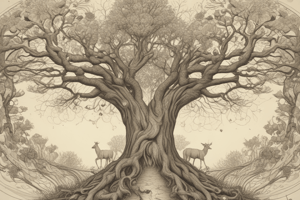Podcast
Questions and Answers
What characterizes neglectful parenting?
What characterizes neglectful parenting?
- High demands and high involvement
- High involvement and high support
- High demands and low responsiveness
- Low demands and low responsiveness (correct)
Which type of aggression is characterized by intent to achieve a specific goal?
Which type of aggression is characterized by intent to achieve a specific goal?
- Proactive Aggression
- Reactive Aggression
- Instrumental Aggression (correct)
- Hostile Aggression
Which of the following behaviors is an example of reactive aggression?
Which of the following behaviors is an example of reactive aggression?
- Yelling insults at someone out of anger
- Bullying another child for popularity
- Planning a revenge attack against a peer
- Hitting someone back after being pushed (correct)
What motivation underlies hostile aggression?
What motivation underlies hostile aggression?
Which of the following could be a physical sign of child abuse?
Which of the following could be a physical sign of child abuse?
Proactive aggression differs from reactive aggression in that it is:
Proactive aggression differs from reactive aggression in that it is:
What is a common effect of neglectful parenting on children?
What is a common effect of neglectful parenting on children?
Which emotional sign may indicate potential child abuse?
Which emotional sign may indicate potential child abuse?
What is the primary focus of the microsystem in Bronfenbrenner's model?
What is the primary focus of the microsystem in Bronfenbrenner's model?
What is a key aspect of Stage 5 in Kohlberg's theory of moral development?
What is a key aspect of Stage 5 in Kohlberg's theory of moral development?
Which parenting style is characterized by high demands and low responsiveness?
Which parenting style is characterized by high demands and low responsiveness?
Which stage in Gilligan's theory reflects a balance between personal needs and the needs of others?
Which stage in Gilligan's theory reflects a balance between personal needs and the needs of others?
What effect can permissive parenting have on children?
What effect can permissive parenting have on children?
In Bronfenbrenner's model, what does the mesosystem consist of?
In Bronfenbrenner's model, what does the mesosystem consist of?
How does Gilligan's theory differ from Kohlberg's theory of moral development?
How does Gilligan's theory differ from Kohlberg's theory of moral development?
Which system represents the outermost layer influencing an individual's development?
Which system represents the outermost layer influencing an individual's development?
What is an essential question for someone in Stage 6 of Kohlberg's moral development?
What is an essential question for someone in Stage 6 of Kohlberg's moral development?
What is a potential characteristic of children raised by authoritative parents?
What is a potential characteristic of children raised by authoritative parents?
What is the focus of individuals in the Orientation to Self stage of Gilligan's moral development?
What is the focus of individuals in the Orientation to Self stage of Gilligan's moral development?
How does the exosystem differ from the microsystem?
How does the exosystem differ from the microsystem?
What does Bronfenbrenner's model postulate about development?
What does Bronfenbrenner's model postulate about development?
What is a common negative outcome associated with the crisis of 'Trust vs. Mistrust' in Erikson's first stage?
What is a common negative outcome associated with the crisis of 'Trust vs. Mistrust' in Erikson's first stage?
Which behavior might indicate a child is experiencing issues related to 'Autonomy vs. Shame and Doubt'?
Which behavior might indicate a child is experiencing issues related to 'Autonomy vs. Shame and Doubt'?
What is a possible behavioral sign indicating developmental delays?
What is a possible behavioral sign indicating developmental delays?
In Erikson's theory, which is a positive outcome of the stage 'Identity vs. Role Confusion'?
In Erikson's theory, which is a positive outcome of the stage 'Identity vs. Role Confusion'?
Which system in Bronfenbrenner's model emphasizes the influence of time and historical context on development?
Which system in Bronfenbrenner's model emphasizes the influence of time and historical context on development?
Which of the following could be a sign of substance abuse in children?
Which of the following could be a sign of substance abuse in children?
What is an example of a behavioral sign of trauma in children?
What is an example of a behavioral sign of trauma in children?
What crisis is faced during the preschool stage according to Erikson's theory?
What crisis is faced during the preschool stage according to Erikson's theory?
At what age do children typically begin to develop theory of mind?
At what age do children typically begin to develop theory of mind?
What is the primary focus of false belief tasks in assessing theory of mind?
What is the primary focus of false belief tasks in assessing theory of mind?
In Kohlberg's theory, what is the main characteristic of Stage 1: Obedience Orientation?
In Kohlberg's theory, what is the main characteristic of Stage 1: Obedience Orientation?
What question represents the thinking pattern of Stage 3: Good Boy/Girl Orientation in Kohlberg's model?
What question represents the thinking pattern of Stage 3: Good Boy/Girl Orientation in Kohlberg's model?
Which level of Kohlberg's moral development focuses on adherence to rules and laws?
Which level of Kohlberg's moral development focuses on adherence to rules and laws?
What is a significant outcome of developing theory of mind?
What is a significant outcome of developing theory of mind?
What distinguishes Stage 2: Instrumental Exchange Orientation from Stage 1 in moral development?
What distinguishes Stage 2: Instrumental Exchange Orientation from Stage 1 in moral development?
Which ability is NOT a key aspect of theory of mind?
Which ability is NOT a key aspect of theory of mind?
Flashcards are hidden until you start studying
Study Notes
Bronfenbrenner's Theory of Development
- Human development occurs within interconnected systems: microsystem, mesosystem, exosystem, macrosystem, and chronosystem.
- Microsystem: Innermost layer; immediate environments like family, school, peers, and neighborhood.
- Mesosystem: Interactions among different microsystems; for example, parental influence on school behavior.
- Exosystem: Broader societal structures; includes workplace, government, and media that indirectly affect individuals.
- Macrosystem: Outermost layer; cultural and societal values, beliefs, and customs influencing development.
- Chronosystem: Historical and cultural context affecting development over time.
Parenting Styles and Their Impacts
- Parenting styles significantly influence child development.
- Authoritarian Parenting:
- Characteristics: High demands, low responsiveness; strict rules and reliance on punishment.
- Effects: May lead to obedient but anxious or withdrawn children with low self-esteem.
- Permissive Parenting:
- Characteristics: Low demands, high responsiveness; lenient with few limits.
- Effects: Often leads to happy and creative children but may struggle with self-discipline.
- Authoritative Parenting:
- Characteristics: High demands and responsiveness; sets clear expectations while being supportive.
- Effects: Children tend to be confident, self-reliant, and socially skilled.
- Neglectful Parenting:
- Characteristics: Low demands, low responsiveness; uninvolved parenting.
- Effects: Can result in feelings of neglect, insecurity, and risk of engaging in harmful behaviors.
Types of Aggression
- Aggression involves intent to harm; various types explain different motivations and contexts.
- Instrumental Aggression: Goal-oriented behavior used to achieve desired outcomes, driven by benefits such as power or status.
- Hostile Aggression: Motivated by anger; intended to inflict pain or harm, connected to negative emotions.
- Reactive Aggression: Response to perceived threats; driven by self-protection or retaliation.
- Proactive Aggression: Planned and premeditated; aims for power or dominance, not a response to provocations.
Signs of Child Abuse
- Physical Signs: Unexplained injuries, poor hygiene, fear of physical contact, physical withdrawal.
- Emotional Signs: Behavioral changes such as aggression or withdrawal, fear of adults, nightmares, low self-esteem.
- Developmental Delays: Delays in cognitive, social, or emotional development, difficulties in learning.
- Behavioral Signs: Early substance abuse, truancy, and runaway behaviors may indicate abuse.
- Sexual Signs: Inappropriate sexualized behavior, genital injuries, and fear of specific adults.
Erikson's Psychosocial Development Stages
- Outlines eight stages with a crisis or conflict that must be resolved for healthy development.
- Stage 1 (Infancy): Trust vs. Mistrust; positive outcome leads to trust and security.
- Stage 2 (Toddlerhood): Autonomy vs. Shame; positive outcomes foster independence and confidence.
- Stage 3 (Preschool): Initiative vs. Guilt; leads to a sense of initiative and curiosity.
- Stage 4 (School Age): Industry vs. Inferiority; develops competence and achievement.
- Stage 5 (Adolescence): Identity vs. Role Confusion; forms a strong sense of self and belonging.
Marcia's Identity Achievement Theory
- Developed based on Erikson's work; focuses on exploration and commitment in identity development.
Theory of Mind
- Refers to the understanding that others have their own thoughts and feelings, enabling empathy and perspective-taking.
- Develops around ages 3-4; assessed through tasks that illustrate understanding of false beliefs.
Kohlberg's Theory of Moral Development
- Divides moral development into three levels, each with two stages emphasizing cognitive growth:
- Level 1: Preconventional Morality; morality is self-serving.
- Level 2: Conventional Morality; focuses on social approval and law.
- Level 3: Postconventional Morality; emphasizes individual rights and universal ethical principles.
Gilligan's Perspective on Moral Development
- Critiques Kohlberg's theory for bias; introduces a care-based approach to moral reasoning.
- Stages include:
- Orientation to Self: Focus on personal needs.
- Orientation to Others: Prioritization of others' needs.
- Orientation to Self and Others: Balances personal and others' needs.
Studying That Suits You
Use AI to generate personalized quizzes and flashcards to suit your learning preferences.




